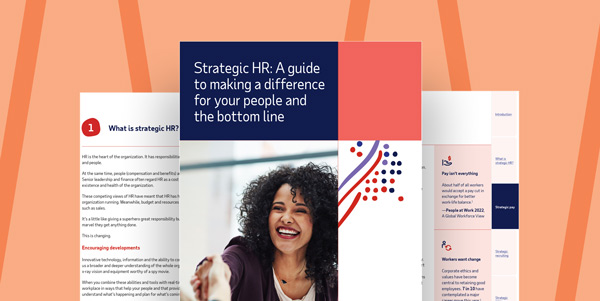Last updated: November 17, 2025
Compensation benchmarking involves analyzing data to determine salaries and hourly wages that are competitive and consistent with market rates. It’s an essential aspect of maintaining pay equity in the workplace today.
Compensation benchmarking key takeaways:
- Benchmark data reduces the guesswork often associated with compensation management.
- Compensation benchmarking can help businesses compete for talent in different markets while adhering to hiring budgets.
- Compensation benchmarks are available through people analytics solutions; some offer real-time insights into labor market trends, hiring practices and talent availability.
Attracting top talent with competitive compensation is a fine needle to thread. Employers might want to land a candidate, but they also have to stay within budget and maintain pay equity throughout their organization. In some cases, they may not even know the market pay range or how much to offer. Compensation benchmarking provides a potential solution to these problems.
Table of Contents
What is compensation benchmarking?
Compensation benchmarking is a data-driven process of determining how much to pay an employee. Employers look at what competitors in their area are paying people in similar roles and then make an offer to the employee that’s consistent with market value and complies with applicable laws.
Elements of compensation benchmarking
When analyzing data to find the salary range for a particular position, employers usually consider a number of factors, including:
- Geographic region
- Industry
- Business size
- Cost of living
- Job responsibilities
- Candidate education
- Candidate skills or credentials
Why is benchmarking important?
Benchmarking salary is important because it reduces the guesswork of compensation management. With accurate data, employers may be able to:
- Compete with other companies for top talent
- Attract qualified candidates for open positions
- Formulate pay transparency strategy
- Adhere to hiring budgets and reduce costs
- Comply with pay equity requirements
Where does compensation benchmarking data come from?
Leading people analytics solutions supply benchmark data. ADP® DataCloud, for instance, offers real, up-to-date, aggregated and anonymized compensation data derived from ADP’s U.S. client base (42 million+ employees). This comprehensive coverage gives employers unrivaled benchmarking precision.
Other sources of benchmark data include:
- Salary surveys
- Data-sharing networks
- HR publications
- Networking communities
How to do compensation benchmarking
Having data is one thing, but knowing how to use it effectively is another. Here are some steps employers take when benchmarking compensation:
- Categorize all positions
Organize jobs by role, job family or department, track (manager or individual contributor), level of experience, and location to ensure that like data is compared to like data during benchmarking. - Acquire benchmark data
Use reliable sources and recheck the data often to ensure it hasn’t become outdated. - Compare internal data to benchmark data
Filter the two data sets by location, percentile (competitive rate), job family, etc. to help determine if employees are underpaid or overpaid. - Record the methodology
Document the filters applied to each position so that future benchmarking exercises reflect comparable data.
How do employers analyze compensation packages?
Survey data can quickly become outdated, which is why many employers today rely on people analytics and compensation management software. These solutions gather data from various sources and provide real-time insights into labor market trends, competitor hiring practices and talent availability. With this information, employers can drive consistent pay across job roles and levels and align compensation packages with industry standards.
Can employers evaluate compensation without benchmarking?
Employers can conduct an internal analysis of their compensation packages, but it will only take them so far. They can measure pay gaps within their organization by gender, race, ethnicity, job location and job title. A people analytics solution may also estimate the cost of closing those gaps.
Knowing what constitutes fair pay in the open market, however, requires salary benchmarking tools. Without information on what competitors in the same industry and location are paying their people, employers may find it difficult to attract and retain talent and control labor-related costs.
Frequently asked questions about compensation benchmarking
How do employees respond to compensation benchmarking?
Benchmarking may be seen as a commitment to fair pay, which can have a positive impact on retention and talent acquisition. In fact, workers who believe their pay is fair are 2.8x more likely to recommend their employer to friends and family as a place to work than employees who feel they are underpaid.1
What are compensation or salary benchmarking best practices?
When benchmarking pay, it’s essential to think about not only where the business is today, but where it expects to be several years from now. For example, if employers plan to hire a substantial number of employees or expand into a new location, they may want to benchmark their compensation against larger companies and businesses in their desired region of expansion. Markets are also always changing, so it’s necessary to revisit benchmarks every so often as part of a compensation strategy.
What are the benefits of compensation benchmarking?
Pay benchmarking helps employers make smarter decisions about their compensation packages. Consequently, they’re better able to find common ground between what talented individuals expect to be paid for their performance and what the organization can financially afford. Compensation benchmarking also supports fair pay policies and compliance with equal pay laws.
This guide is intended to be used as a starting point in analyzing compensation benchmarking and is not a comprehensive resource of requirements. It offers practical information concerning the subject matter and is provided with the understanding that ADP is not rendering legal or tax advice or other professional services.





